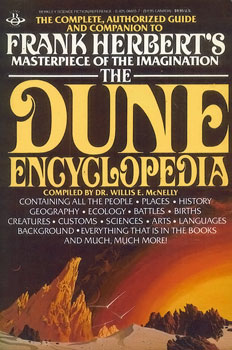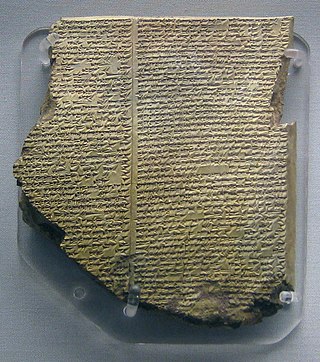Related Research Articles

Peter Douglas Nicholls was an Australian literary scholar and critic. He was the creator and a co-editor of The Encyclopedia of Science Fiction with John Clute.

Tik-Tok is a 1983 science fiction novel by American writer John Sladek. It received a 1983 British Science Fiction Association Award.

The Dune Encyclopedia is a 1984 collection of essays written by Willis E. McNelly and multiple other contributors as a companion to Frank Herbert's Dune series of science fiction novels.

An extraterrestrial or alien is any extraterrestrial lifeform: a lifeform that did not originate on Earth. The word extraterrestrial means "outside Earth". The first published use of extraterrestrial as a noun occurred in 1956, during the Golden Age of Science Fiction.

Voyage to the City of the Dead (1984) is a science fiction novel by American writer Alan Dean Foster.
Planets outside of the Solar System have been featured as settings in works of fiction. Most of these fictional planets do not vary significantly from the Earth. Exceptions include planets with sentience, planets without stars, and planets in multiple-star systems where the orbital mechanics can lead to exotic day–night or seasonal cycles.

The concepts of space stations and space habitats feature in science fiction. The difference between the two is that habitats are larger and more complex structures intended as permanent homes for substantial populations, but the line between the two is fuzzy with significant overlap and the term space station is sometimes used for both concepts. The first such artificial satellite in fiction was Edward Everett Hale's "The Brick Moon" in 1869, a sphere of bricks 61 meters across accidentally launched into orbit around the Earth with people still onboard.

Immortality is a common theme in fiction. The concept has been depicted since the Epic of Gilgamesh, the oldest known work of fiction. Originally appearing in the domain of mythology, it has later become a recurring element in the genres of horror, science fiction, and fantasy. For most of literary history, the dominant perspective has been that the desire for immortality is misguided, albeit strong; among the posited drawbacks are ennui, loneliness, and social stagnation. This view was challenged in the 20th century by writers such as George Bernard Shaw and Roger Zelazny. Immortality is commonly obtained either from supernatural entities or objects such as the Fountain of Youth or through biological or technological means such as brain transplants.

Science Fiction: The 100 Best Novels, An English-Language Selection, 1949–1984 is a nonfiction book by David Pringle, published by Xanadu in 1985 with a foreword by Michael Moorcock. Primarily, the book comprises 100 short essays on the selected works, covered in order of publication, without any ranking. It is considered an important critical summary of the science fiction field.
The Steps of the Sun is a 1983 science fiction novel by the American author Walter Tevis. It is about a future energy crisis, and a world in which China has become the leading superpower.
Disasters in popular culture includes real and fictional disasters, as depicted by the media, and are considered social events. Disaster movies made in Hollywood are part of the American pop culture. Catastrophe types can include hostile aliens, climate change/global warming, environmental disasters, financial crises, natural disaster, nuclear apocalypse, pandemics, super heros, terrorist attacks, zombies and other technological meltdowns.
Anatomy of Wonder — A Critical Guide to Science Fiction is a reference book by Neil Barron.
New Worlds: An Anthology is an anthology edited by Michael Moorcock published in 1983.

The Complete Book of Science Fiction and Fantasy Lists is a book written by Malcolm Edwards and Maxim Jakubowski and published in 1983.
Superluminal is a novel by Vonda McIntyre published in 1983.
Fantastic Cinema is a book by Peter Nicholls published in 1984.
The Arabian Nightmare is a novel by Robert Irwin published in 1983. The Arabian Nightmare was inspired by The Arabian Nights, as well as the novel The Manuscript Found in Saragossa by Jan Potocki.
Circumpolar! is a novel by Richard A. Lupoff published in 1984.
Balance of Power is a novel by Brian Stableford published in 1979.
Orbitsville Departure is a novel by Bob Shaw published in 1983.
References
- 1 2 Pringle, Dave (April 1983). Thomson, Keith (ed.). "Book Review". Imagine (review). 1. TSR Hobbies (UK), Ltd.: 16.
- 1 2 DeWeese, Gene (Summer 1983). Geis, Richard E. (ed.). "Book Reviews by Gene DeWeese". Science Fiction Review (review). 12 (2). Richard E. Geis: 20.
- ↑ Langford, David; Stableford, Brian (1983). Nicholls, Peter (ed.). The Science in Science Fiction. New York: Alfred A. Knopf Inc. ISBN 0-394-53010-1.
- ↑ https://www.isfdb.org/cgi-bin/title.cgi?102531